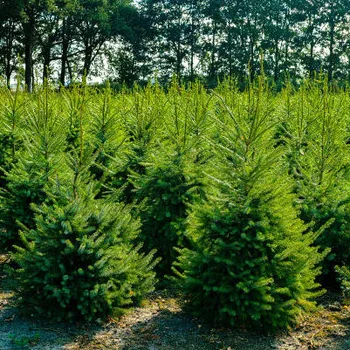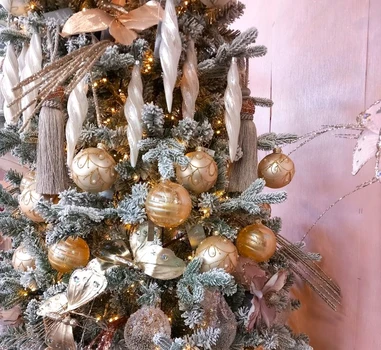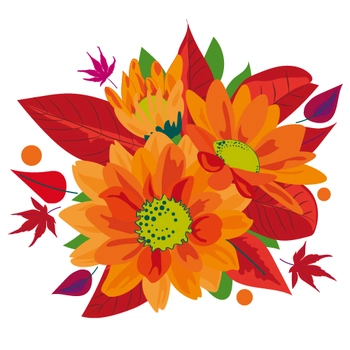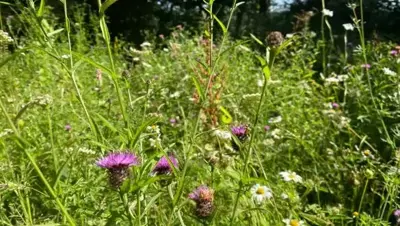

You may have been noticing the trend for ‘no mow’, leaving your lawn that bit longer or even planting a wildflower meadow to benefit insects in your garden. Gradually, the aspiration for that perfectly-mown, stripy lawn is changing to a desire for a wilder, more natural look. Of course this isn’t for everyone, but it might be worth considering, even if it is just a one metre square micro meadow, it could benefit the wildlife in your garden.
A weed is just a plant growing in the wrong place
Simply leave a patch of lawn unmown through the Spring and Summer and you will probably start to see wildflowers appear as the grass grows longer. Some of what pops up will depend on what you start with. Lawns that have been treated with weedkiller and fertiliser will be predominantly grass, but as time goes on more seeds will arrive and add to the variety of plants growing.
If, like me, your lawn is a bit wild anyway it doesn’t take long for daisies, clover, dandelions and buttercups to start flowering. Basically all those plants that we consider weeds – but remember a weed is just a plant growing in the wrong place – so just by changing your perception and thinking about them a bit differently you may grow to love these weeds in the right place!
Try to resist mowing until at least July
Wildflower meadows grow best on poor soil with low nutrients – grass loves nutritious soil and will out-compete native wildflowers, so in this case the worse the soil the better for flowers. If you are hoping to grow a flowering lawn or meadow then I would recommend not fertilising that part of your garden. By leaving your lawn unmown through the Spring and Summer you are replicating the process of haymaking – try to resist mowing until at least July or even through to early September. This gives the plants time to grow, flower and set seed for the next year before you mow.
The challenge is getting your mower through the long grass by this time, so a strimmer or a pair of shears might be needed. Always collect your cuttings as if you were collecting hay, otherwise they will fertilise the soil and make it too nutritious for the flowers to grow next year.
It’s a dilemma when to intervene and when just to let nature take its course
In my garden I have been growing a mini meadow for a few years now.A while ago we had some building work done and I asked the builders to spread the poorer sub soil on an area of the garden so I ended up with an area of less nutritious, more sandy ground.I then sowed a wildflower meadow seed mix onto that area.It contained a blend of grasses and wildflowers including Yellow Rattle.This is an important plant if you are growing a meadow from scratch as it is a hemiparasite which means it fixes its roots onto the grass roots and steals their nutrients and water, thereby weakening the grass and allowing the other wildflowers to establish.
For the first year, once the seed had germinated, we mowed once a month or so to let the plants get established.From the second year we stopped mowing in March and left the meadow to grow until September or October.Now 10 years on we have an interesting mix of plants growing and this has gradually changed over time as some species died out and others became more dominant.
I try to let the meadow do its own thing but I am finding that there is some annoying bindweed growing in there which I am worried will take over.Initially I tried painting the leaves with Roundup Gel, but I am now resisting the use of weedkillers, so I am cutting it back where I can reach it in the hope that this will weaken the roots.
At the margins of the meadow I am getting some dock and nettles growing which are a sign that the soil is too fertile, so again I pull them up if I can to weaken them. It’s a dilemma when to intervene and when just to let nature take its course. Sometimes I think that the meadow looks a bit messy – especially in late Summer as the flowering finishes, but I only have to stop and look at all the insects buzzing about to appreciate the mess from their point of view.I was delighted to count over 20 different flowers
For the purposes of this blog I tried to identify all the different plants that are growing and I was delighted to count over 20 different flowers including Ox-eye daisy, Cow parsley, Meadow Cranesbill, vetch, clovers, dead nettle, mallow, thistles, knapweed, Great Burnett and many more. My ambition is to find an orchid in there one day but so far nothing has appeared.
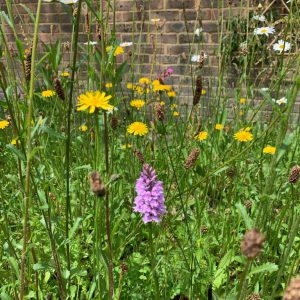
Annoyingly, my mum recently moved and is turning the road verge outside her house into a small meadow. She planted small wildflower plants last Autumn in amongst the grass (this is a great way to establish a meadow rather than seeding). This Spring, three Common Spotted Orchids popped up, much to her delight and my disgust! It just shows how wildflower seed can be there waiting in the soil for the right conditions to grow and we have just got to give them that opportunity.
Make a massive difference for our wildlife
Even if you don’t want to go as far as growing a meadow it can be beneficial for our friends the bees just to mow a bit less. We now only cut our lawn every 3 – 4 weeks, it can get a bit long and straggly but we have plenty of daisies, clover (great nectar plant) and purple self heal flowering in amongst the longer grass and there are always bees to spot on the lawn. Mowing less frequently also makes the lawn better able to cope with the dry hot weather that we are tending to get in our summers.
So, however big or small your lawn, simply changing the way you cut it can make your garden more bee friendly and collectively all the gardens across the UK making this change could make a massive difference for our wildlife.

